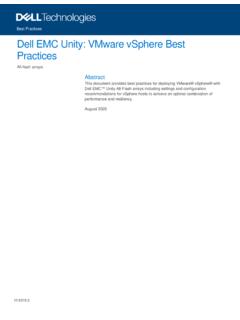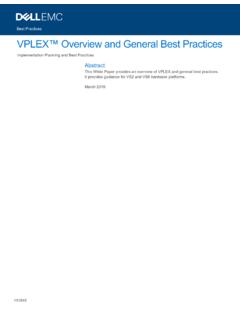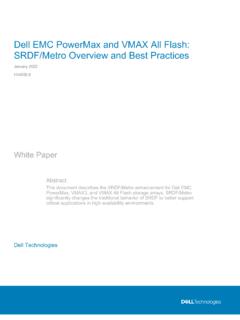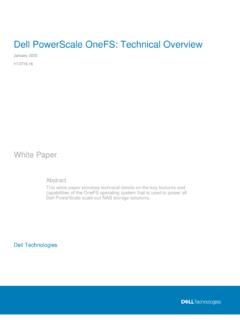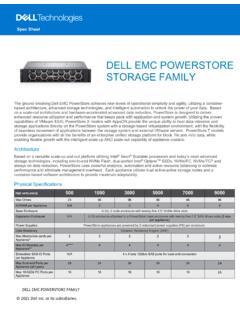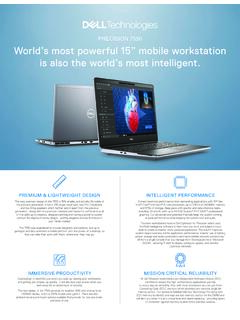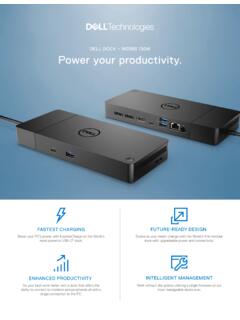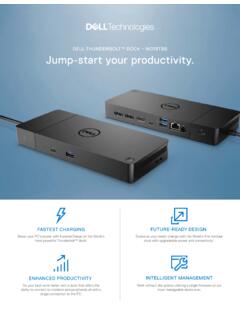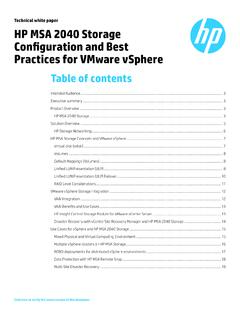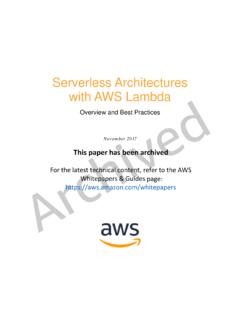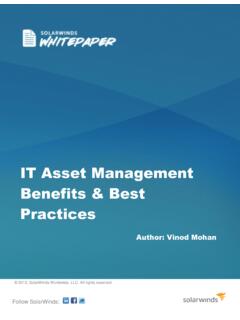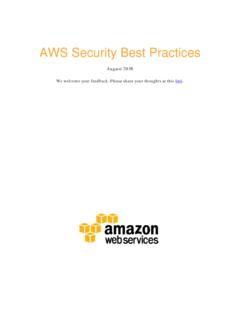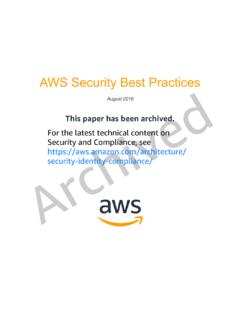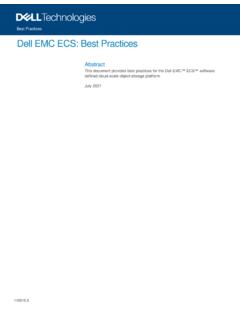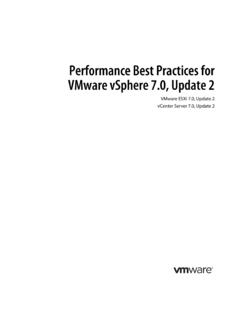Transcription of Dell EMC PowerStore: Best Practices Guide
1 Dell PowerStore: best Practices Guide July 2022 White Paper Abstract This document provides best Practices for installing and configuring Dell PowerStore for optimal performance and availability. Dell Technologies Copyright 2 Dell PowerStore: best Practices Guide The information in this publication is provided as is. Dell Inc. makes no representations or warranties of any kind with respect to the information in this publication, and specifically disclaims implied warranties of merchantability or fitness for a particular purpose.
2 Use, copying, and distribution of any software described in this publication requires an applicable software license. Copyright 2020-2022 Dell Inc. or its subsidiaries. All Rights Reserved. Dell Technologies, Dell, EMC, Dell EMC and other trademarks are trademarks of Dell Inc. or its subsidiaries. Intel, the Intel logo, the Intel Inside logo and Xeon are trademarks of Intel Corporation in the and/or other countries. Other trademarks may be trademarks of their respective owners. Published in the USA July 2022 Dell Inc.
3 Believes the information in this document is accurate as of its publication date. The information is subject to change without notice. Contents 3 Dell PowerStore: best Practices Guide Contents Executive summary .. 4 Introduction .. 4 Hardware considerations .. 6 Network 9 PowerStore storage resources .. 12 PowerStore features and layered applications .. 13 External host considerations .. 14 Conclusion .. 15 References .. 16 Executive summary 4 Dell PowerStore: best Practices Guide Executive summary This white paper provides best Practices guidance for using Dell PowerStore in a mixed-business environment.
4 It focuses on optimizing system performance and availability, and on maximizing the usability of the automated storage features. These guidelines are intended to cover most use cases. They are recommended by Dell Technologies, but are not strictly required. Some exception cases are addressed in this white paper. Less common edge cases are not covered by these general guidelines and are addressed in use case-specific white papers. For questions about the applicability of these guidelines in a specific environment, contact your Dell Technologies representative to discuss the recommendations.
5 This document is intended for IT administrators, storage architects, partners, and Dell Technologies employees. This audience also includes any individuals who may evaluate, acquire, manage, operate, or design a Dell networked storage environment using PowerStore systems. Date Description April 2020 Initial release: PowerStoreOS June 2020 Terminology updates September 2020 Terminology updates June 2021 PowerStoreOS updates January 2022 PowerStoreOS updates; template update July 2022 PowerStoreOS updates Introduction This document introduces specific configuration recommendations that enable optimal performance from PowerStore.
6 PowerStore achieves new levels of operational simplicity and agility. It uses a container-based microservices architecture, advanced storage technologies, and integrated machine learning to unlock the power of your data. PowerStore is a versatile platform with a performance-centric design that delivers multidimensional scale, always-on data reduction, and support for next-generation media. PowerStore brings the simplicity of public cloud to on-premises infrastructure, streamlining operations with an integrated machine-learning engine and seamless automation.
7 It also offers predictive analytics to easily monitor, analyze, and troubleshoot the environment. PowerStore is highly adaptable, providing the flexibility to host specialized workloads Overview Audience Revisions Document purpose PowerStore overview Introduction 5 Dell PowerStore: best Practices Guide directly on the appliance and to modernize infrastructure without disruption. It also offers investment protection through flexible payment solutions and data-in-place upgrades. The following table provides definitions for some of the terms that are used in this document.
8 Table 1. Terminology Term Definition Appliance A solution containing a base enclosure and any attached expansion shelves. The size of an appliance could be the base enclosure only or the base enclosure plus expansion shelves. Base enclosure Refers to the enclosure that contains both nodes (node A and node B) and 25 NVMe drive slots. Cluster One or more appliances in a single grouping and management interface. Clusters are expandable by adding more appliances to the existing cluster, up to the allowed amount for a cluster.
9 Embedded module Connectivity card in the PowerStore node that provides ports for Ethernet connections, and various service and management ports. Expansion enclosure Enclosures that can be attached to a base enclosure to provide additional storage in the form of SAS drives. Fibre Channel A protocol used to perform NVMe or SCSI commands over a Fibre Channel (FC) network. File system A storage resource that can be accessed through file-sharing protocols such as SMB or NFS. Internet SCSI (iSCSI) Provides a mechanism for accessing block-level data storage over network connections.
10 I/O module Optional connectivity cards that provide additional Fibre Channel or Ethernet ports. IOPS I/Os per second, a measure of transactional performance for small-block workloads. MBPS Megabytes per second, a measure of bandwidth performance for large-block workloads. Network-attached storage (NAS) server A virtualized network-attached storage server that uses the SMB, NFS, or FTP/SFTP protocols to catalog, organize, and transfer files within file system shares and exports. A NAS server, the basis for multi-tenancy, must be created before creating file-level storage resources.
